Top Wilmington Health Careers: Jobs & TrainingTop Wilmington Health Careers: Jobs & Training
The healthcare sector in Wilmington offers a diverse range of professional opportunities. These roles encompass various specializations, from direct patient care to administrative and support functions, contributing to the overall









